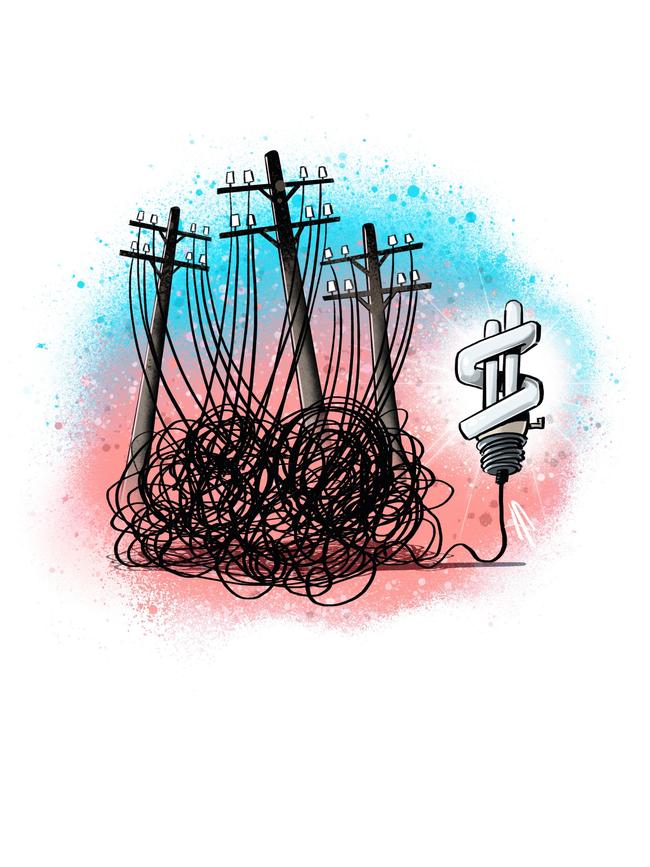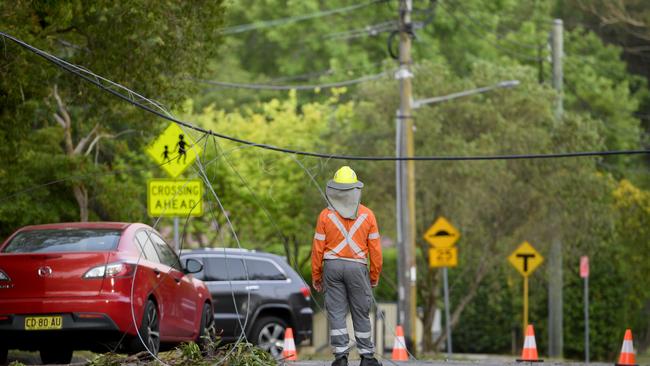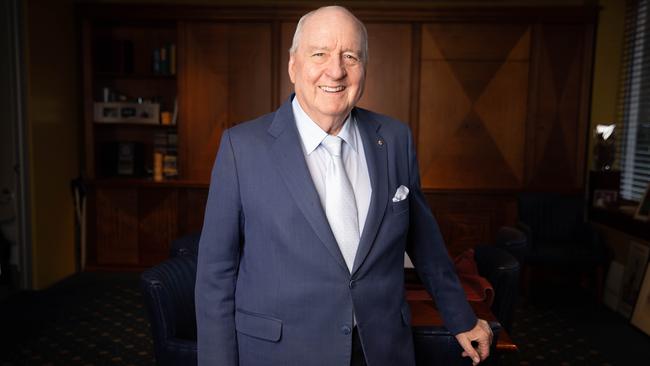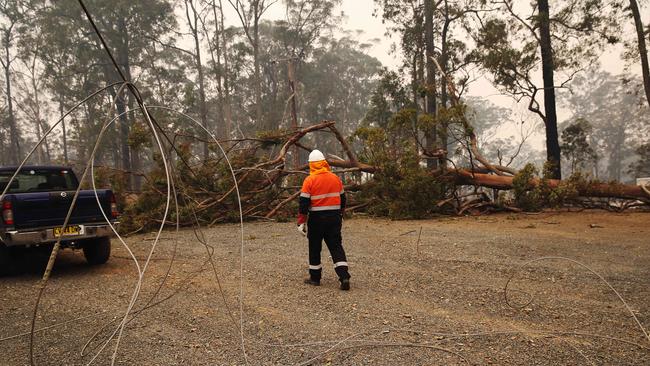Public in the dark in NSW electricity debacle
The electricity game in our state is played on a wildly uneven field, and the losers are always innocent and increasingly powerless members of the public, writes Alan Jones.
Opinion
Don't miss out on the headlines from Opinion. Followed categories will be added to My News.
- No money for farmers in $1b drought package
- Bureaucrats, pollies to blame for fires not climate change
It defies belief in a country supposedly in the first, as opposed to third, world that there are still nearly 2000 homes and businesses without power.
This is now more than a week since the devastating storm that, according to Ausgrid, the state’s biggest electricity provider, created damage to over 200 suburbs in Sydney “on a par with a cyclone”.
Yes, there were broken telegraph poles, trees felled everywhere and power lines down.
But don’t these things happen in a storm? And aren’t instrumentalities like Ausgrid — which charges us beyond what often we can afford — are we now being told they are only here for the good times.


When this all began, customers and businesses, many worried about refrigerated stocks being destroyed, or butcher shops and cafes unable to do any business, couldn’t find a human being to talk to.
Instead, they were being referred to a website.
It’s a bit hard to get onto a website when you don’t have any power.
But if this sounds like black humour, it may be that the appalling adversity of customers, which still goes on, has given us an opportunity to understand the farce that the energy and electricity industry has become, both in organisation and cost.
While the damage is unarguably huge, what has clearly emerged is that the state’s largest electricity provider is hopelessly understaffed.
Ausgrid provides power to more than 1.7 million homes and businesses in New South Wales.
But here is the rub, expressed in one word: privatisation.
What does it mean?
Governments take the money with very little regard for the consequences to the customer.
Michael Baird sold off the state’s poles and wires for 99 years for $16.2 billion to a consortium that included Australian Super.
But this occurred after a lightning-fast eight-week unsolicited proposal process.
Forget the fact that there has been significant argument as to whether the price paid was the enterprise value of the asset.

Some say the figure was up to $5 billion short.
Critics of the privatisation of these significant utilities always ignore the fact that, while these outfits were in public hands, middle management became bloated — white-collared officers at Ausgrid were spending $240,000 a year on Cabcharges alone.
It is easy to command big salaries when the taxpayer is paying the bill.
But an effective government can surely remedy that.
Instead, when Ausgrid was privatised, the budgets were slashed.
But instead of clearing out middle management, hundreds of the best and most skilled workers were made redundant. So now Ausgrid has 2000 fewer employees than they did five years ago.
In fact, 325 Ausgrid workers have been let go in the last two months.
And 80 per cent of those were frontline staff.
You do not need to be too smart to know that Ausgrid is undermanned, and in the weather crisis that overtook parts of Sydney a week ago they have been found out.
Think of this unbalanced equation.
Our population is increasing.
We have more houses and more businesses.
But the largest electricity company in the state has fewer frontline repair workers than ever.
The only conclusion that can be drawn is that the privatisation of Ausgrid has left us with the provision of a critical public service hopelessly undermanned to handle these sorts of events.
However, that is only the beginning of the story.
The issue is electricity, or lack of it.
Only in Australia could you have six different energy bodies, all of them taxpayer funded, with a finger in our energy pie.
The Australian Energy Regulator controls the price of electricity and gas.
That alone rings alarm bells.
The government flogs off the biggest electricity company in the state, but some other outfit tells that company how much it can or cannot charge and how much it can or cannot spend.

Then there is the Australian Energy Market Operator.
Don’t start me on that lot.
They are part of the reason the energy market is in such a mess.
Coal-fired power is demonised because this outfit is run by renewable energy zealots.
Somehow we also have an Energy Security Board, supposedly in charge of guaranteeing energy security in this country, which is hopelessly impossible if you seek to wipe coal-fired power out of the equation.
Then you have Energy Consumers Australia.
They are supposed to provide residents and small business with a voice.
The poor consumer and businessmen had no voice last week.
They couldn’t even get someone to pick up the phone to tell them how long this farce would continue.
Then there is the Australian Energy Market Commission, who “make the rules which govern the energy markets in this country”.
What rules? What market?
A market in which a bias exists in favour of renewable energy, which makes essential fossil fuel energy uncompetitive.
This is like playing a rugby Test with 15 on one side and 10 on the other.
You can’t be surprised when the team with 15 wins.
If renewable energy is fraudulently subsidised by the taxpayer, why would people invest in any other form of energy generation.
But only in Australia.
According to the American-based environmental group, Global Energy Monitor, 147 gigawatts worth of power stations will be built or reopened in the world this year; and that almost equals the existing capacity of the European Union.
Our capacity is not even 70 — and 27 gigawatts are produced by coal-fired power.
China built almost twice that capacity in the 12 months to June this year via 43 coal-fired power stations.
This country is going nuts, blinded by ideology.
Then, of course, you have this Clean Energy Finance Corporation, which give your money to renewable energy without your consent.
Tony Abbott’s Coalition government won 25 seats from the Labor Party in two elections promising to abolish the Clean Energy Finance Corporation.
And yet the Morrison Coalition government has just given them another billion.
Work that out.
But back to Ausgrid.
One of these outfits, the Australian Energy Regulator, actually determines how much revenue Ausgrid is allowed to make.
And they make this determination every five years.
Is this privatisation?

It sounds like socialism to me.
No wonder we can’t clear a few trees and repair some poles and wires.
Every five years, Ausgrid must submit proposals that explain to the Australian Energy Regulator their proposed capital and operating costs.
And the Australian Energy Regulator has to tick this off.
And Ausgrid then sets their profits based on the ruling from the Australian Energy Regulator.
Are you still with me?
Because here’s the rub.
In the energy mess we are in, the government wants to tell you that they are forcing down electricity prices by having some bloated statutory authority telling a private sector outfit, Ausgrid, how much they can earn and spend.
And this — or so the government believes — will force them to cut electricity prices.
Then last Tuesday comes along and the rubber hits the road.
By forcing Ausgrid to cut expenditure, it is 2000 staff short — including skilled frontline workers.
Ausgrid has been told by this Australian Energy Regulator — in January this year — that the revenue they were entitled to recover from their customers in 2014-19 was $9.1 billion.
Ausgrid overshot the mark, so they had to return $310.9 million to their customers and, hey presto, we are forcing the electricity price down.
But common sense will tell you that if they cannot secure their profits by pricing their electricity, of course they will have to sack staff.
So, sack the staff and you have more than 20 suburbs of Sydney without power.
The author of this mess is not just Ausgrid, but also its partners in abandoning customers — governments, state and federal.
Listen to the Alan Jones Breakfast Program on 2GB weekdays from 5.30am-9am

